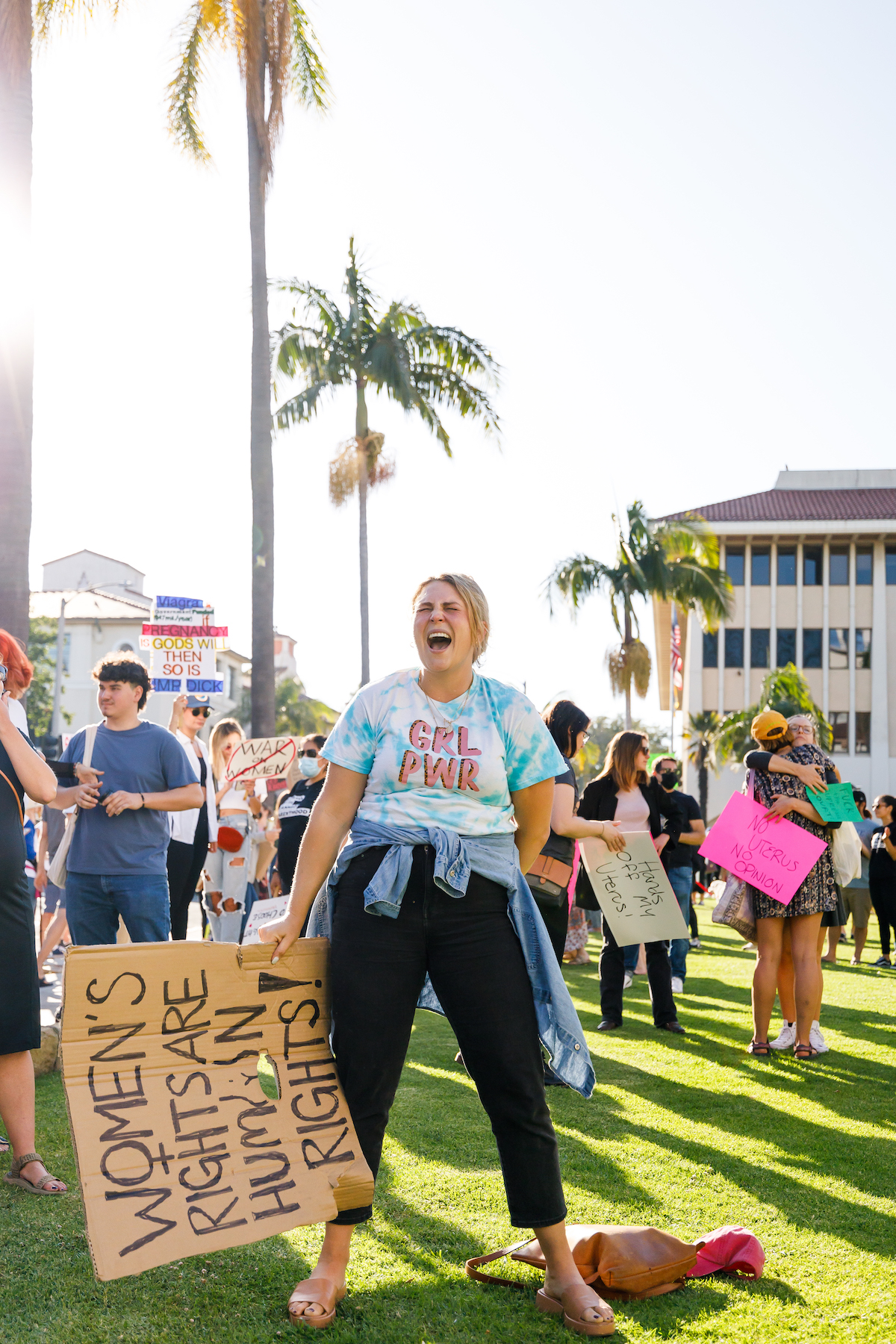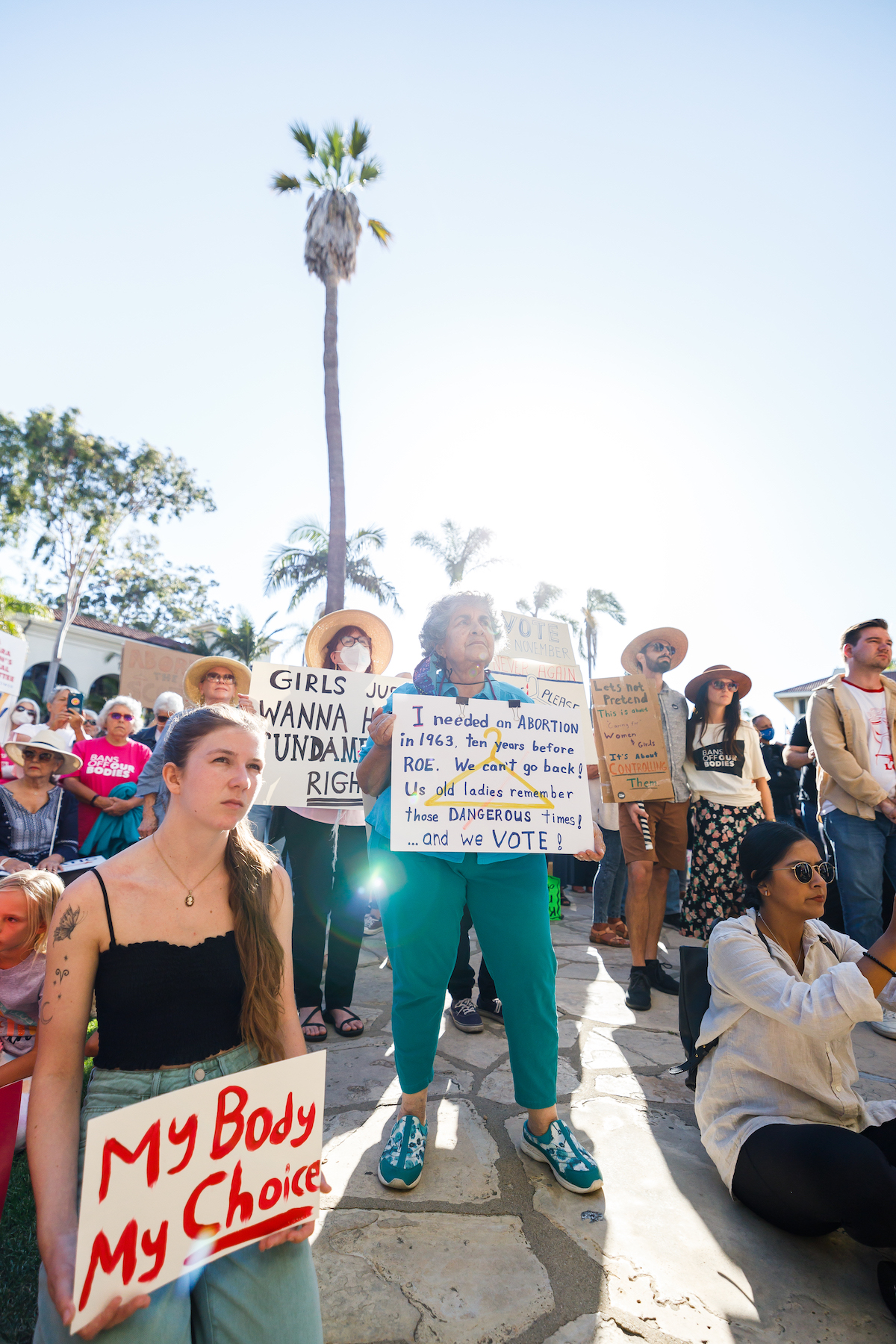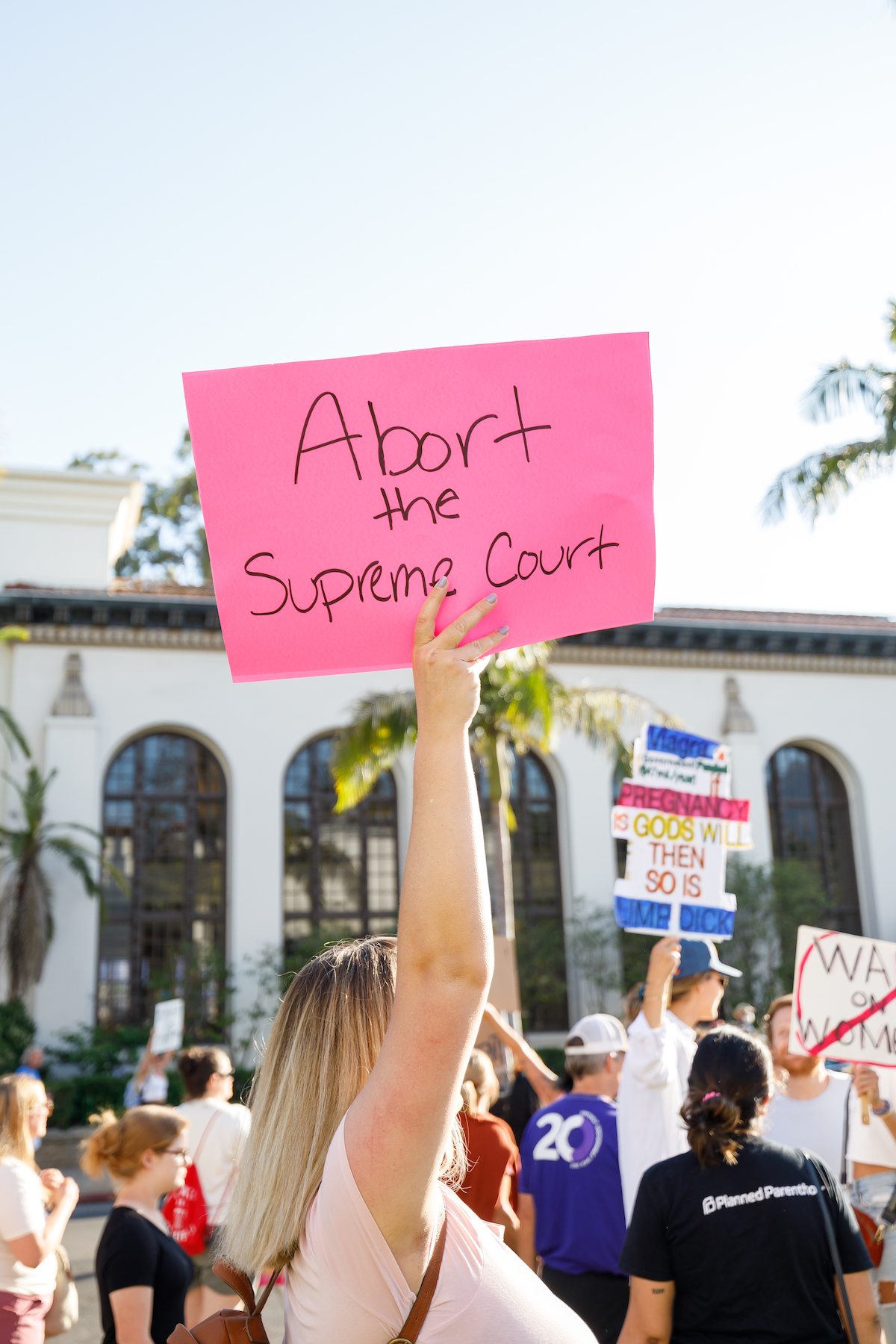Santa Barbarans Blast the Loss of ‘Roe v. Wade’
Anti-Abortion Ruling Sets Loose Protests in S.B. and Planning for Women’s Health Care Nationwide
By Jean Yamamura with Jun Starkey | June 30, 2022



Credit: Ingrid Bostrom
Sex and violence combined at the Supreme Court when abortion and guns were the focus of two decisions this past week: one telling states to decide how to regulate abortion and the other telling states to keep their hands off guns in public.
The same day, June 24, nearly 600 people who believe in the right to an abortion streamed onto the Santa Barbara courthouse lawn with passing cars honking support during a Friday afternoon rally. One young woman, who stood stock still among the crowd shouting, “I AM SO ANGRY,” echoed the feelings heard nationwide from hundreds of thousands of protesters.
Over at Santa Barbara’s Girls Inc., young people were gathered for summer activities, skills development, and camaraderie, all with the aim of fulfilling the program’s goal to make girls strong, smart, and bold. Program Director Jen Faust said the teens among them were well aware of what was up that day: “Young women, teens, they’ve lived with these rights all these years, and they’re asking, ‘What’s the next thing that’s going to be taken from us?’ “ They were talking about how to get to a position where they could become a Supreme Court justice, said Faust: “We’re trying to raise hope, keep them safe and healthy, and give them the skills to speak up for themselves, to build a society that stands up for girls and young women.”

According to the Guttmacher Institute, which researches reproductive health policy, 26 states are likely to impose or have imposed abortion bans, joining countries such as Iraq, Sierra Leone, Egypt, and the Philippines where women’s reproductive rights do not exist. The backlash against the Supreme Court’s decision is having some unintended consequences. For young women thinking about scholarships and colleges, media outlets like Teen Vogue are warning them to look before they jump. Free tuition may be offered at universities in Texas, for instance, but it’s also a state with one of the most repressive laws in the nation, banning abortion after conception; women’s health clinics, which can dispense contraceptives, are struggling to stay open across Texas.
How was Trump able to put three conservative justices on the bench? Each of them said during Senate hearings that they would observe the tradition of precedence — such as upholding Roe v Wade — but, with this ruling, have failed to do so. Neil Gorsuch, Brett Kavanaugh, and Amy Coney Barrett voted with Samuel Alito and Clarence Thomas to remove all federal protections for abortion in the Dobbs v. Jackson Women’s Health Organization case. In his decision, Alito cited a long history of laws against abortion, among them the onetime Chief Justice of the King’s Bench, Englishman Matthew Hale, who called abortion a “great crime” when of a moving child in the womb. Many critics have raised the fact that the Massachusetts witch trials of the late 17th century were modeled after Hale’s 1662 sentencing of two elderly widows to death for witchcraft, and it was Hale who ruled that husbands could legally rape their wives.
Yet Alito’s claim that abortion was prohibited from the “earliest days of common law to 1973” was not so cut and dried, said Patricia Cohen, an emerita professor of history at UC Santa Barbara. While he opined that laws outlawing abortion in the 19th century came out of an overwhelming concern for fetal personhood, Cohen said the public outrage was more due to the deaths of many young women killed during botched abortions, deaths that were much publicized by newspapers in the late 1800s. In the states passing subsequent laws that made abortion illegal, Cohen pointed out that in the few times a person was charged, juries often failed to convict or handed down light sentences; those who were convicted served for months, not years. “It wasn’t seen as great or wonderful,” Cohen said. “It was never a right. It was just off the radar.”

“Today’s ruling is the first time the Supreme Court has taken away previously established rights covering millions of Americans,” said Santa Barbara County Supervisor and attorney Joan Hartmann. “And the courts won’t stop here,” she warned. “Clarence Thomas added a concurrent opinion that other major precedents establishing rights to basic things like birth control (Griswold) and marriage equality (Obergefell) are on the table for dismantling. This ruling is about asserting who has control over your future — and it is especially meant to control and punish women, people of color, poor people, and other marginalized communities.”
Among the least visible individuals in the fallout from the Dobbs decision are transgender men who retain their uterus and ovaries. Attorney Kristin Flickinger, who heads Pacific Pride Foundation, noted, “Up to 30 percent of trans men have unintended pregnancies.” She also pointed out that Thomas’s opinion directly contradicts Alito, who limited his ruling to abortion. “It’s very clear. This is not a standalone judgment,” Flickinger said. “Roe and Casey are part of a line of decisions that guarantee rights based on the privacy doctrine, penumbral rights, because the word ‘privacy’ is not in the Constitution, and when you take one of these building blocks out of this legacy, the others can fall very easily.”
Legal scholars will be dissecting Dobbs for decades to come, but in the immediate now, states including California, New York, and Colorado are preparing to receive an influx of women of child-bearing-age, as many as 36 million, who, for whatever reasons, are in no position to have a child.

In California as many as 1.3 million women could seek abortion care coming from a neighboring state such as Arizona, which bans abortion after 15 weeks. One state away, Idaho will make it a felony after six weeks, and Utah may include abortion through medication as a felony, with a $10,000 fine and up to 15 years in prison.
Mifepristone — known as RU 486 — a medication that can end a pregnancy up to 70 days after conception, was recently authorized to be prescribed through telemedicine by the Food and Drug Administration. Jenna Tosh, who leads the tri counties’ branch of Planned Parenthood, cautioned that the drug was not so easily obtained; in Santa Barbara, for instance, the clinic dispenses it only after an in-person visit. As well, 19 states require a clinician to be in the room when the medication is taken, the Guttmacher Institute found; two states have prohibited it after a certain number of weeks.
Getting an abortion in any case has never been a simple process, especially for women who lack funds or support. Laury Oaks, head of the Feminist Studies Department at UC Santa Barbara, said, “There are barriers like travel, childcare, taking time off of work. And they just keep going higher and higher.”

Pathways for care, however, are forming “by people doing this work for a long time who know how to do it,” according to Oaks, though plans are made quietly given the violence that abortion provokes in opponents. Underground-railroad-type networks have organized to quickly move women from their home states to clinics elsewhere.
California is adding $200 million in funding for access to reproductive health care, and a dozen bills in the Legislature are already headed for Governor Newsom’s desk. Monique Limón, Santa Barbara’s state senator, said the bills all had a great chance of being passed. “[They] will move us from relying on the federal government to ensuring that our states have these protections in place,” she said, especially when “bordering states may not be providing care and may leave a lot of people without vital services.”
Newsom signed a bill on Friday to protect abortion providers from civil liability judgments outside California and made an executive order to safeguard the privacy of medical records. Other bills look to protect professionals from out-of-state retaliation by ensuring medical privacy in blocking out-of-state subpoenas, blocking investigations upon pregnancy loss, and preventing revocation of professional licenses for providing services in other states. Some bills focus on equity and communication in recruiting a diverse health-care workforce, advancing California to be a “Reproductive Freedom” state, and creating a universal webpage for abortion care. November’s ballot will offer a constitutional amendment for the right to abortion in California, a Senate bill endorsed by Assemblymember Steve Bennett and State Senator Limón.
“Abortion is still safe and legal in California,” reminded Supervisor Hartmann, who said she was “deeply saddened and mad as hell” over Alito’s decision. “We must ensure that California will continue to be a beacon of hope for pregnant people in need of basic health care, including safe abortion care … for the thousands of people who will need to come here because they had these rights stripped away with this reprehensible ruling.”

Read all of the stories in our cover package, “Sex and Violence and the Supremes,” here.




You must be logged in to post a comment.